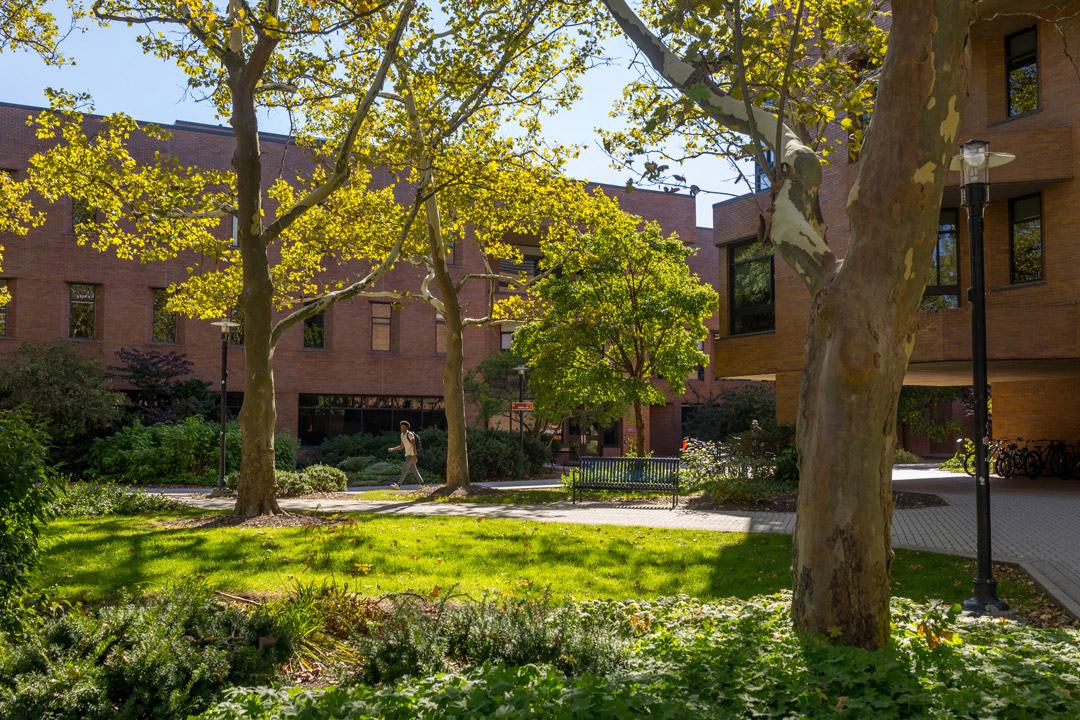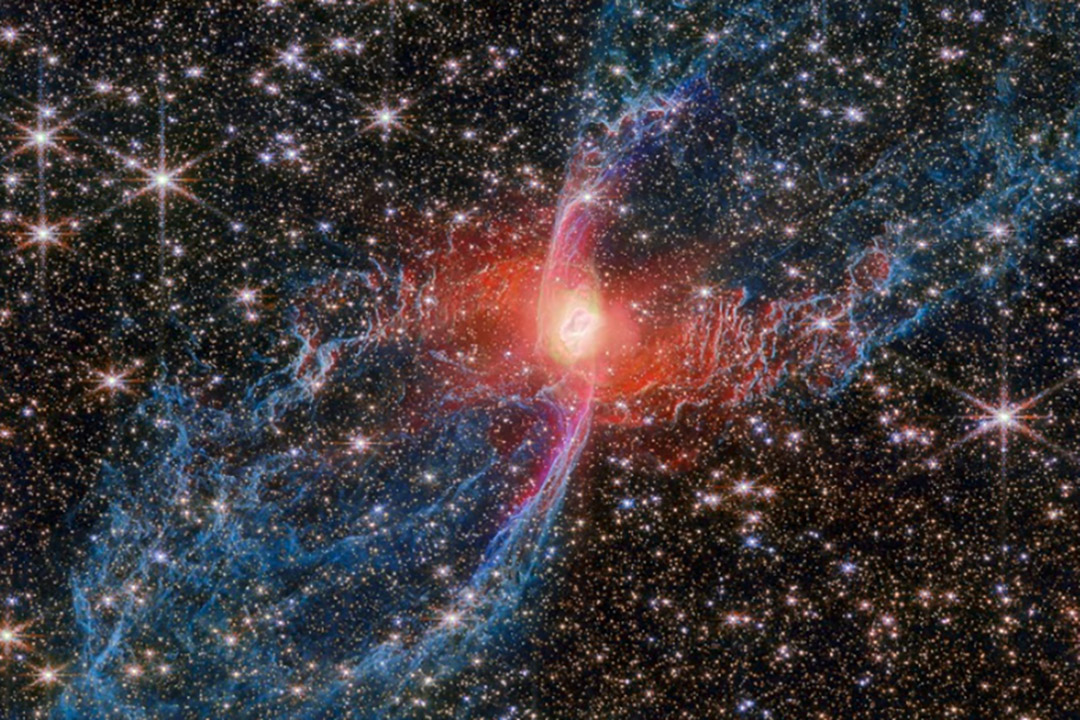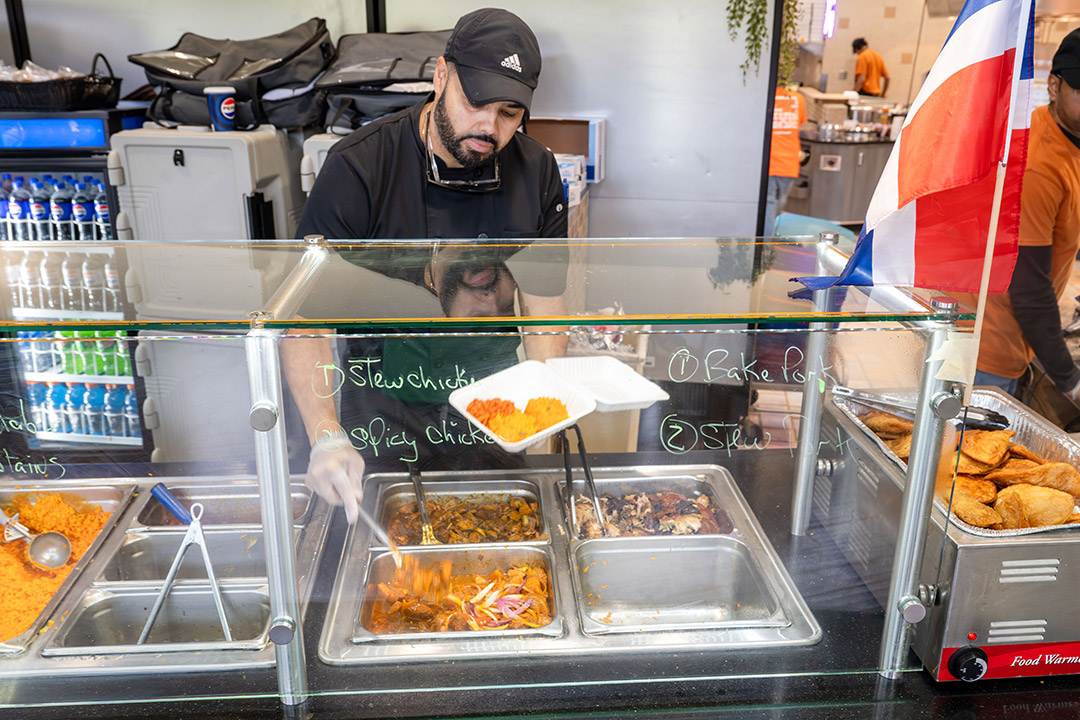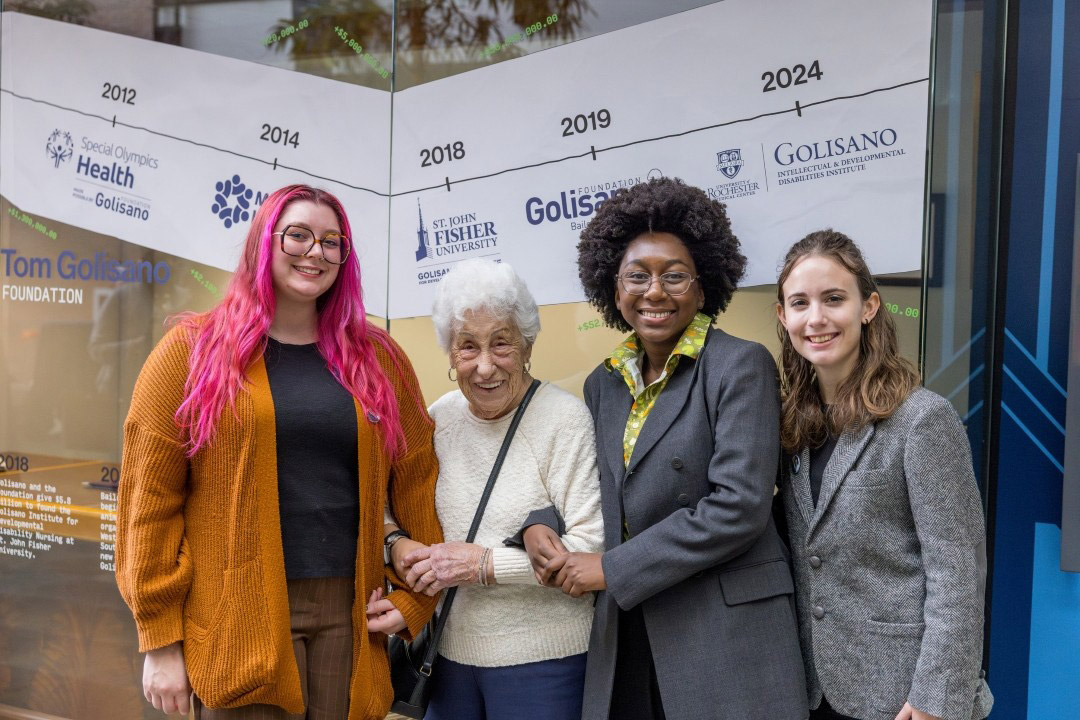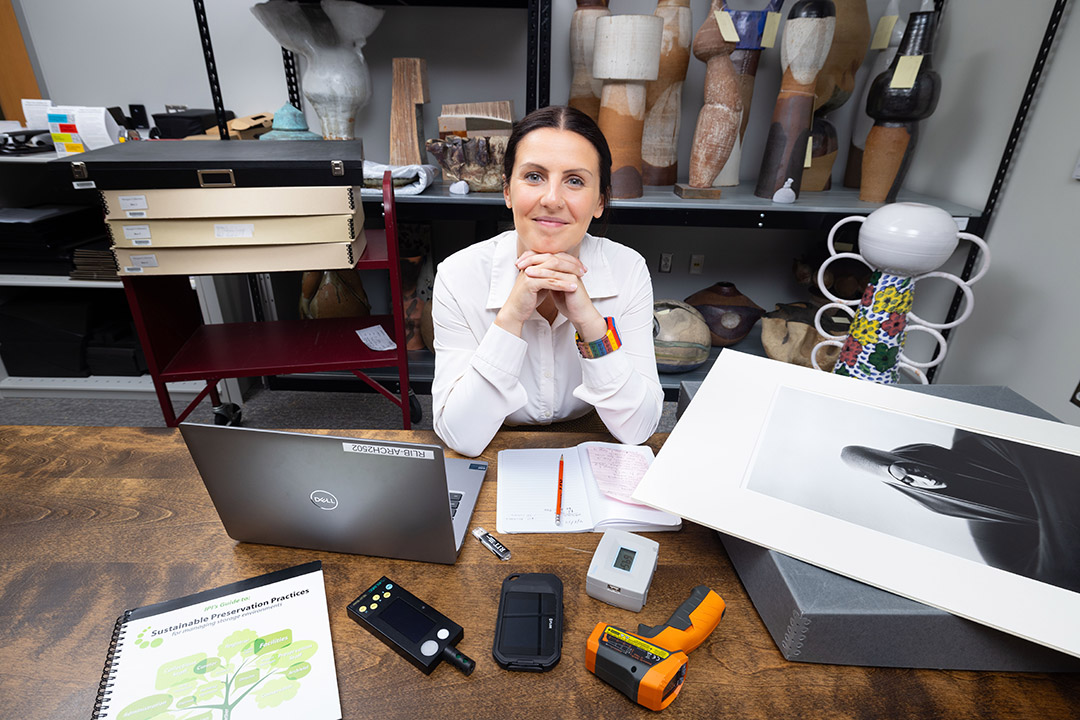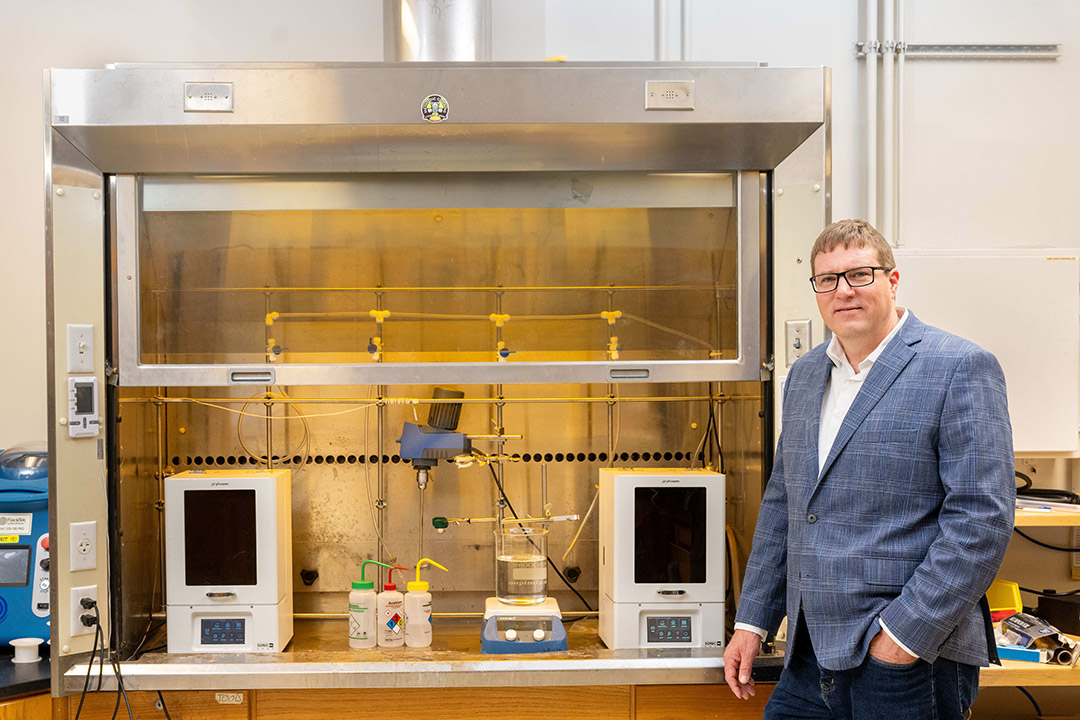RIT Big Shot team blitzes Highmark Stadium
Rochester Institute of Technology commemorated the Buffalo Bills’ final season at Highmark Stadium on Oct. 11 with a one-of-a-kind photograph that will be displayed in the new stadium when it opens next year.
The 360-degree, extended exposure nighttime photo was created during the 37th RIT Big Shot, an annual event that has highlighted Croatia’s medieval Old Town in Dubrovnik, Cowboys Stadium, Churchill Downs, The Alamo, and dozens of locations in the United States. The project began in 1987 to teach RIT students how to solve complicated problems with simple tools and teamwork.
On Oct. 11, thousands of students and community volunteers used flashlights and other light sources to “paint” the 52-year-old stadium with light, while the Big Shot camera team captured the image.

Big Shot team
This year’s Big Shot marked the first year the team created a full 360-degree panoramic image of a subject. The above image will be displayed in the new stadium when it opens next year.
Eric Kunsman, co-coordinator of the Big Shot and assistant professor at RIT’s National Technical Institute for the Deaf, said the support from the regional community made this one of the biggest Big Shot events in recent years.
“Whether people came out because they love photography, the Bills, or both, the fact that we had thousands of people working together to create one photo is a powerful experience,” he said. “When people see the photo online or in the new stadium, they can point to where they stood or where they pointed their flashlight to help create the image. It’s an incredible memory for everyone involved.”
This year marked the first time that the Big Shot team captured a full 360-degree panoramic image of a subject. In addition to the panoramic photograph, the team captured six additional photographs to ensure every inch of the stadium was documented.
Rebecca Villagracia, a fourth-year photojournalism student from Orange County, Calif., has set her sights on a career in professional sports photography after graduation. Participating in the Big Shot was both a fun way to contribute to Buffalo Bills’ history and a learning opportunity.

Big Shot team
Over 6,000 volunteers came out to help create the Big Shot photograph this year. Each “brushstroke” of light in the image above was created by Big Shot volunteers.
Villagracia operated one of the six additional cameras placed at the top of the stadium, along with one of the Buffalo Bills’ photography interns.
“This was kind of a once-in-a-lifetime type of opportunity,” she said. “I’ve photographed in baseball and basketball stadiums, but a football stadium is so much larger. I also don’t do a lot of nighttime photography where you’re just keeping the camera shutter open for a minute or two, so incorporating that into an aspect of sports photography with the unique venue was definitely something cool to learn.”
Dan Hughes, Big Shot co-coordinator and lecturer in the School of Photographic Arts and Sciences in RIT’s College of Art and Design, said creating opportunities like this for students and the RIT photography community is always top-of-mind.
“There is no better way to learn than by working alongside someone in the same position that a student might aspire to be in after they graduate,” said Hughes. “We’re grateful that the Buffalo Bills photography team helped make this possible for them.”
Big Shot No. 37 was made possible by partnering with the Buffalo Bills and CEPA Gallery. The event is sponsored and organized by the School of Photographic Arts and Sciences in RIT’s College of Art and Design, NTID’s Department of Visual Communication Studies, Nikon, and the Estate of Henry D. Navas ’74 (MBA), ’77 MS (accounting) and Deborah L. Robbins. Other sponsors include Mccrae Industries, Hill + Valley Creative, and Scott’s Rochester Photo Supply.
The final panoramic photograph will be available to purchase on the Big Shot website after Oct. 20. All six additional images will be posted to the website in the coming days.
To keep up with the Big Shot community, go to the Big Shot Facebook page.
Latest All News
- Simons Empire Faculty Fellowship to fund four College of Science positionsRIT’s College of Science will receive funding from the Simons Empire Faculty Fellowship program for four new tenure-track faculty members. The four positions are in priority areas of mathematics, neuroscience, physics, and ecology and evolutionary biology. Each award is for $825,000, for a total of $3.3 million, and will provide salary, fringe, and start-up support for the positions for three years. “This award is a tremendous opportunity for the College of Science to continue its upward trajectory in research and innovation,” said André Hudson, dean of the College of Science. “By recruiting outstanding junior faculty, we are not only strengthening our academic community but also advancing RIT’s commitment to cutting-edge research, discovery, and scholarly excellence. These new faculty hires will help shape the future of science at RIT and ensure that our faculty, staff, and scholars are at the forefront of fundamental and translational breakthroughs.” The Simons Foundation and Simons Foundation International (SFI) established the Simons Empire Faculty Fellowship program to accelerate faculty recruitment and strengthen research in mathematics and the basic sciences at institutions across New York State. Through this program, SFI provides funding to support the hiring of junior tenure-track or equivalent faculty whose research advances fundamental scientific discovery. The recommendation for funding comes through support from RIT’s Office of Corporate and Foundation Relations. “Especially given the current political and higher education landscape, the university recognizes the need to strategically seek a wide set of opportunities to bring in world-class faculty and to facilitate groundbreaking research,” said Sara Vinch, assistant vice president of corporate and foundation relations. “Our office supports RIT faculty while building strong external partnerships with the goal of harnessing opportunities such as these. We are so grateful to the foundations for their support." Hudson noted that a team of College of Science personnel were instrumental in the effort to submit a successful proposal. Those include Larry Buckley, senior associate dean; Kate Wright, head of the Thomas H. Gosnell School of Life Sciences; Michael Murdoch, head of the Integrated Sciences Academy; Seth Hubbard, head of the School of Physics and Astronomy; and Joshua Faber, head of the School of Mathematics and Statistics. Once the college submits offer letters for each position, along with other supporting documents, the foundation will issue intent-to-fund letters for each position by July 2026.
- RIT research reveals new details in the Red Spider NebulaA creepy, crawly object in the middle of the Milky Way can now be seen clearer than ever thanks to work by RIT scientists. The Red Spider Nebula, catalogued as NGC 6537 and named for its distinct shape, has been given a new makeover by James Webb Space Telescope near-infrared (NIRCam) imaging complemented by new Atacama Large Millimeter Array (ALMA) radio-wavelength and Chandra X-ray Observatory observations and archival Hubble Space Telescope images. The combination of observations with the three most powerful NASA telescopes and the world’s most powerful radio observatory provides a dramatic, new view of the nebula, yielding insight into its origins, structure, and composition. ESA/Webb, NASA, CSA, Kastner An annotated image of the Red Spider Nebula shows details of the structure as never seen before. The research is led by RIT Chester F. Carlson Center for Imaging Science Professor Joel Kastner and former postdoctoral researcher Paula Moraga Baez ‘21 MS, ‘24 Ph.D. (astrophysical sciences and technology), with the help from RIT alumnus Rodolfo Montez Jr. ‘11 Ph.D. (astrophysical sciences and technology). NTID Associate Professor Jason Nordhaus was a co-author. The findings were released in The Astrophysical Journal, and the image was featured as the European Space Agency’s Halloween-themed picture of the month for October. Other co-authors of the paper include Bruce Balick (University of Washington), Caroline Geiser (Max Planck Institute, Germany), Mikako Matsuura (Cardiff University, United Kingdom), and Miguel Santander-Garcia (Spanish National Observatory).
- Visiting chefs and family recipes offer international flavor to RIT meal optionsWhile pizza, burgers, salads, and subs remain popular choices for hungry college students, there are more options than ever before at RIT dining halls thanks to ethnic dishes brought by visiting chefs and family recipes from staff. “The visiting chef program continues to bring exciting new flavors to campus,” said Herlan Manurung, corporate executive chef and associate director for RIT Dining. “Each visiting chef contributes something new, building on the diverse options our community has access to.” The visiting chefs, nine this semester, rotate among the Ritz, Kitchen at Brick City, and the Café and Market at Crossroads for lunch and dinners during weekdays when classes are in session. “This program also helps our staff learn new culinary techniques and recipes that these restaurants offer,” Manurung said. “Our community comes from different parts of the United States as well as many international countries. By offering a variety of food as well as foods from different cultures, we are hoping to make them feel at home.” Ike Ansari and his cousin Yasin Rao were the first visiting chefs at RIT in 2004, when they brought food from their nearby restaurant, Pakistani House, to campus. The reaction was so good that they eventually closed their restaurant and began P.H. Express to focus on providing more than 1,400 lunches and dinners a week to RIT. Using recipes from his mother and wife, Ansari serves four Halal dishes from Pakistan and India, including his most popular, tandoori chicken with barbecue curry sauce, and vegetable biryani. Each day, he’ll cook up 60 pounds of rice and 120 pounds of chicken, place it in hot boxes and transport it in their van to campus. It’s not uncommon to find 15 to 20 people in line waiting for them to open. “Our food taste is not typical of a restaurant,” Ansari said. Peter Schuck/RIT Sous Chef Kenny McNair provided recipes from his late grandmother’s Puerto Rican dishes for the International Bar at Gracie’s. Employee family recipes are just one way RIT is offering diverse menu items. While Ansari has heard many international students say the food reminds them of home, 90 percent of his customers are not of Pakistani or Indian heritage, he said. Luis Tejeda, who owns D’Mangu restaurant in Rochester, has provided Dominican lunches and dinners five times a week on campus for about 12 years. “Everything’s authentic and seasoned specially,” he said, as he and his cousin, William Del Rio, served hungry students at Crossroads. He posts two small flags from the Dominican Republic, his native country, on the counter when he’s serving. “Where else are you on campus?” asked one student. “Your food is the best. Your pulled pork is terrific.” Chefs specializing in dishes from Nigeria, Korea, and Peru, as well as chefs specializing in sushi and macaroni and cheese (gluten-free or with barbecued chicken and bacon if desired) also partner with RIT, and more may be considered. The diverse menu options don’t always come from off campus. Some recipes are from current employees. Kenny McNair, a sous chef at Gracie’s, stepped up to provide recipes of dishes his late grandmother, who was born in Puerto Rico, used to make. Now her pink beans and rice, plantains, salsa verde pork, tuca en escabeche, and pollo guisado chicken are featured at Gracie’s Latin Bar, which rotates each semester at its international station, along with Indian, Southern, and Caribbean offerings. One student who ordered the beans and rice said she enjoys trying all of the different options as opposed to eating the same thing every day. “It makes me feel good. I’m glad people are enjoying it. It’s all about the enjoyment of eating,” McNair said.
- New exhibit celebrates Golisano’s philanthropyRIT is celebrating entrepreneur and philanthropist B. Thomas Golisano’s legacy with a student-curated exhibit in the Golisano College of Computing and Information Sciences atrium. Members of the Golisano Foundation and Golisano’s sister, Marie Golisano Graham, visited RIT on Oct. 22 for the exhibit opening. The installation, “A Good Deal for Everyone,” focuses on the response to Golisano’s philanthropic contributions through his Golisano Foundation, which was established 40 years ago. “It’s a beautiful exhibit that really fits in with the spirit of giving,” said Golisano Graham. Traci Westcott/RIT Landyn Hatch, from the RIT Archives, spoke about ways that the archives provide impactful source material for students to shape exhibits and share stories. The title of the exhibit is based on a quote from Golisano, “Be brave, be fair, act with integrity and above all, always strive to create a good deal for everyone.” The display includes a historical timeline of Golisano’s giving and recreated thank you cards from people touched by the Golisano Foundation. “When I think about the tangibility of Tom and Marie’s legacy, I always come back to the thank you cards,” said Landyn Hatch, innovation and engagement archivist in the RIT Archives. “Everyone can look at the cards hanging in this case and find something that relates to them.” In 2024, Golisano gave $500 million to various community organizations, including a $10 million gift to RIT. Public gratitude for his generosity is showcased by the hundreds of thank you cards still being archived in the RIT Archives’ B. Thomas Golisano Collection today. Student curators Nicole Feldman and Sophie Abatiell Tommola, both museum studies majors, developed the exhibit concept. Fourth-year graphic design major Ashley Persia created the installations in the Command+g Design Lab, a woman’s design group in the College of Art and Design and a collaborative partner with the RIT Archives. Traci Westcott/RIT A new exhibit from the RIT Archives’ B. Thomas Golisano Collection showcases recreated thank you cards from those impacted by Golisano’s philanthropy. “The waves in front of the thank you cards represent the waves of gratitude that people have for Mr. Golisano’s support,” said Persia. “It was amazing seeing something that I worked on go from an idea on a small screen to becoming a huge exhibit for everyone to enjoy.” Amina Davila-Webster, a fourth-year graphic design major, worked on the historical timeline of Golisano’s giving. She said that the timeline begins at a drawing of a printing calculator—the same machine that Golisano used when creating Paychex that now sits on the desk in the exhibit. The team also produced a timeline for the Wallace Library that documents the numerous student-curated exhibits and projects that grew from the Golisano Collection donated in 2015 by Golisano Graham.
- RIT preservation specialist empowers cultural heritage institutions to adopt sustainable practicesCultivating sustainability in the workplace can look vastly different between industries. While maintaining climate-controlled storage spaces year-round may seem antithetical to the pursuit of environmentally conscious practices, it is a non-negotiable for preserving objects at museums, libraries, and archives. Fortunately, collecting institutions have options for responsibly managing preservation environment needs. Emily Bernal and her colleagues at RIT’s Image Permanence Institute (IPI) are dedicated to helping these institutions adopt more eco-friendly methods for managing these climate control systems. “I think sustainability should be part of the conversation for anything that we do in this field,” said Bernal, IPI’s sustainable preservation specialist. “I feel lucky to act as a bridge between the fields of environmental science, the social sciences, and humanities in this role. What I’m doing is still a little unique, but I’m hoping that we’ll see more positions like mine in the future.” In recognition of IPI’s contributions to the field of sustainable preservation—like the widely-used eClimate Notebook resource—the institute was selected to participate in the new Getty Global Art and Sustainability Fellows program. Fifteen cultural and scientific organizations across six continents were invited to participate in the inaugural year of the program. IPI is one of only two United-States-based institutions included in the program. At IPI, the program will provide funding to support a series of three two-year fellowships over the next six years. Bernal was selected as IPI’s first fellow. This new multi-year global initiative was created by the Getty to support early-career professionals and visual artists “at the forefront of international conversations on climate resiliency,” according to the Getty’s press release. All fifteen participating organizations are known internationally for boosting sustainability in the arts and cultural heritage fields. “Our goal with the Getty Global Fellows program is to create a network of changemakers working to protect collections, buildings, and sites in the face of accelerating climate change,” said Joan Weinstein, director of the Getty Foundation. “IPI’s excellence and international reputation in providing accessible tools and training in cultural preservation makes them an essential and welcome addition to the Getty Global cohort.” Being invited to participate in the program was a “feel good moment” for IPI Executive Director Jennifer Jae Gutierrez. “When we saw the other recipients, it was surprising to see quite a wide breadth of institutions represented. IPI being part of that cohort demonstrates the value of our work now, and the work that we’ve done for decades. It acknowledges that the resources we create have really made a difference,” Gutierrez said. As a sustainable preservation specialist, Bernal uses her background in environmental science to research current and potential best practices for climate control management, specifically in relation to mechanical operations as well as passive environmental control. Her primary role is to serve as a consultant for collecting institutions who are starting or strengthening their sustainable environmental management practices, and she leads technical support for IPI’s web-based environmental analysis software, eClimateNotebook. Support from the Getty fellowship program will enable Bernal to continue this work, with a special focus on creating more resource guides that highlight the multifaceted benefits of sustainable preservation practices and enable more institutions to implement sustainable preservation environmental management. “A big selling point we lean into is that, in many instances, when institutions achieve these sustainability goals, they can have the same preservation outcomes, or even better preservation outcomes, while also lowering energy use and the cost associated to maintaining these environments,” she said. Amplifying some of the field’s current success stories in this area is another major goal of Bernal’s fellowship. “I really want other institutions to see themselves reflected in these publications. I hope they can read the success stories of similar institutions and be inspired to think, ‘even if I can’t follow all of these guidelines, I think I can make some changes now that I’ve seen how they’ve done it elsewhere,’” she said.
- Researchers develop self-healing materials to improve 3D-printing processesSelf-healing materials are being developed by RIT researchers to further improve additive manufacturing, specifically 3D-printed products, to make them stronger and more resilient. Christopher Lewis and members of his research team developed a stimuli-responsive photopolymer solution—liquid resins similar in texture to superglue—that once printed exhibits the ability to self-heal when damaged, and through the lithography process, these liquid resins solidify selectively, layer-by-layer. There is a lot of interest today in materials that can heal, or self-repair, themselves. In 3D printing, the ability to build more reliable parts that have these healing actions can benefit multiple industries and provide cost savings. Companies can rely more confidently on the strength of materials being used for high-precision equipment such as printed electronics, soft robotics, or prosthetics for the aerospace, automotive, and biomedical fields, said Lewis, an associate professor and Russell C. McCarthy Endowed Professor in RIT’s College of Engineering Technology. “When you break a bone, or cut yourself, we take it for granted that there is a self-repairing mechanism that allows for bones or skin to rejuvenate themselves, at least to some extent,” said Lewis. “We also learn that it is not true for synthetic materials or man-made objects. And our work in self-healing materials is a futuristics look at how we can develop systems that mimic those natural material properties.” Peter Schuck/RIT Christopher Lewis, left, discussed the cellular nuances related to the self-healing resins with BS/MS student Kaia Ambrose. Ambrose is part of the team focused on shape memory behavior. Over time, 3D-printed objects can crack, particularly those used in load-bearing applications. This is worsened by the fact that many of the materials used in 3D printing are inherently brittle. Without intervention, the structures can fail. The team discovered that by combining a thermoplastic agent with an ultraviolet-curable resin enables a stronger 3D-printing process, while also creating a blend that reinforces cracked areas. “It makes the material much stronger than it used to be. One of the problems with these soft, elastomeric materials is that they are traditionally weak. And it also engenders another type of property—shape memory behavior, and we are just starting to focus our efforts on better understanding this behavior,” said Lewis. At the forefront of this work for several years, Lewis received funding from the U.S. Department of Defense and partnered with scientists in RIT’s AMPrint Center to test how self-healing materials supplement 3D-print processes. He and co-authors Vincent Mei and Kory Schimmelpfennig, RIT doctoral students, detailed the work in several journals including ACS Applied Polymer Materials, Polymer, and a recent issue of 3D Print Industry. Each highlights the team’s focus on the UV-vat polymerization of this liquid resin system. The challenges, he said, are in regulating the viscosity of the reactive resin, and ensuring all materials are soluble and light sensitive. “The approach we have taken is one where we have a mixture of two different things. We have our photoreactive, thermosetting polymer that once cured becomes a soft rubber. To this, we also add a thermoplastic healing agent. We were able to get light to pass through the system, and we achieved that by utilizing polymerization induced phase separation (PIPS). It is a process where the thermoset and thermoplastic materials separate during curing,” he said. “That is key to this whole thing.” PIPS is a single, segmented function where an optically transparent liquid allows light to pass through. By curing the UV resin, the thermoplastic phase separates. Lewis compared that final phase-separated structure to a lava lamp that changes as it is lit or heated. It is similar with the polymers that transform as they are integrated with the 3D-print as each layer is cured. “Earlier work on thermoplastic polymer blends that are able to be processed using conventional techniques like injection molding or extrusion suggested that it was that phase separation that seemed to be driving the self-healing behavior of those systems. That understanding led us down this path of experimentation with this same healing agent and photo reactive polymer system, and then, a little bit of luck,” said Lewis.








